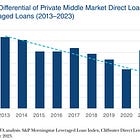Do you remember the first time you saw a Russian nesting doll, or Matryoshka? I was very surprised to see there were smaller dolls nested inside. Perhaps most surprising is how tiny and numerous some of these inner dolls can be.
We have addressed leverage in various aspects throughout this newsletter but never directly discussed the hidden aspects of its use. I intentionally use the word “hidden” because I learned over the years that several investors have not understood (or even noticed) certain forms of leverage in their investments. Learn about the 5 levels of leverage and what to look for when evaluating private credit offerings.
Our matryoshka metaphor is rather obvious from the start so let’s dig into the details. We will illustrate this concept using a traditional commercial real estate (CRE) lending fund but much of this generally applies to private credit funds as a whole.
What’s Leverage?
As a quick review, leverage occurs when a fund borrows money at certain specified terms, including an interest rate and term, and the fund utilizes this to lend to its borrowers. The lender can provide this financing on a secured or unsecured basis. When a fund employs leverage in multiple forms it is crucial to understand the priority of repayment to creditors before investors can claim any residual value of the assets.
If you would like to learn more, or refresh yourself, on basic leverage then you can visit the leverage and fund structure sections of our article below:
The Fund and Its Nesting Dolls
Level 1: The Lending Fund Itself
We will address the equity investment into our lending fund by starting with the fund itself - metaphorically the largest doll holding all the smaller ones within it.
As we discuss these levels it may be helpful to think of this through a financial or accounting lens. I will try to simplify it here as much as possible. If you are interested in learning more about the accounting mechanics you can review our article series (including video instruction) below:






